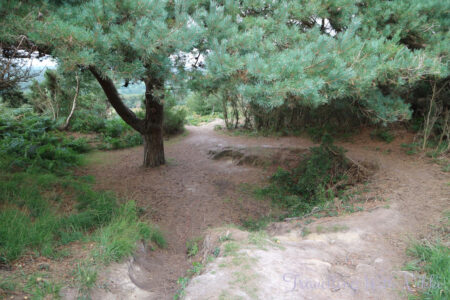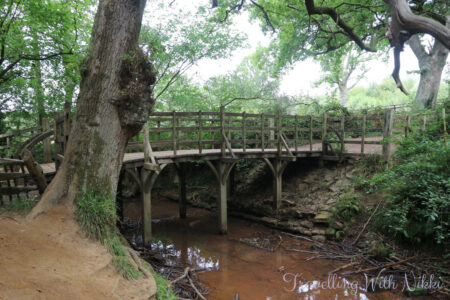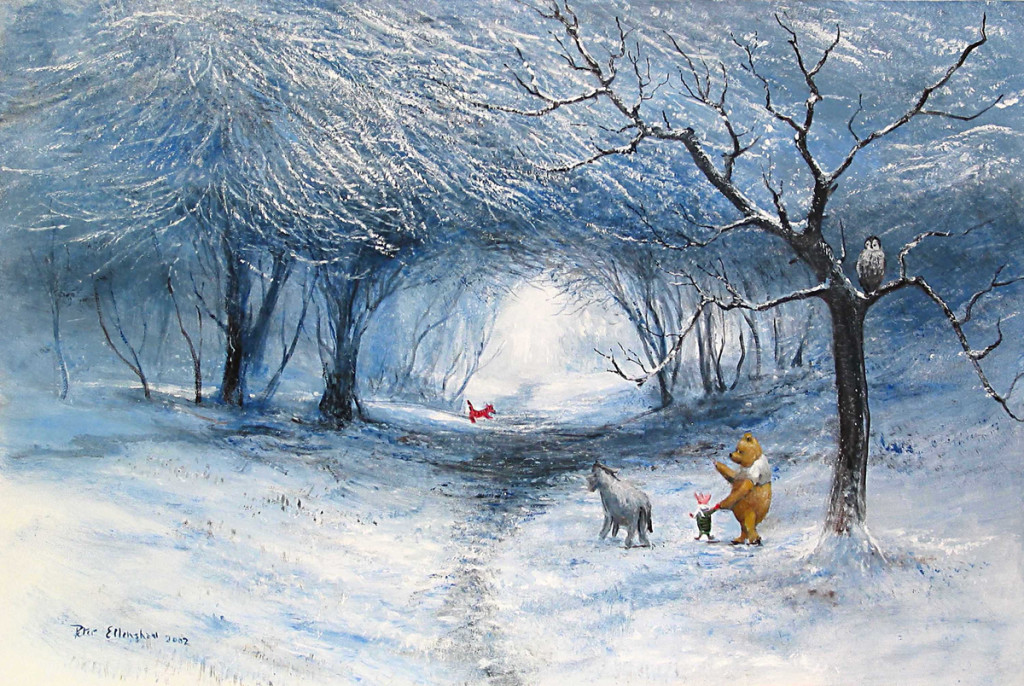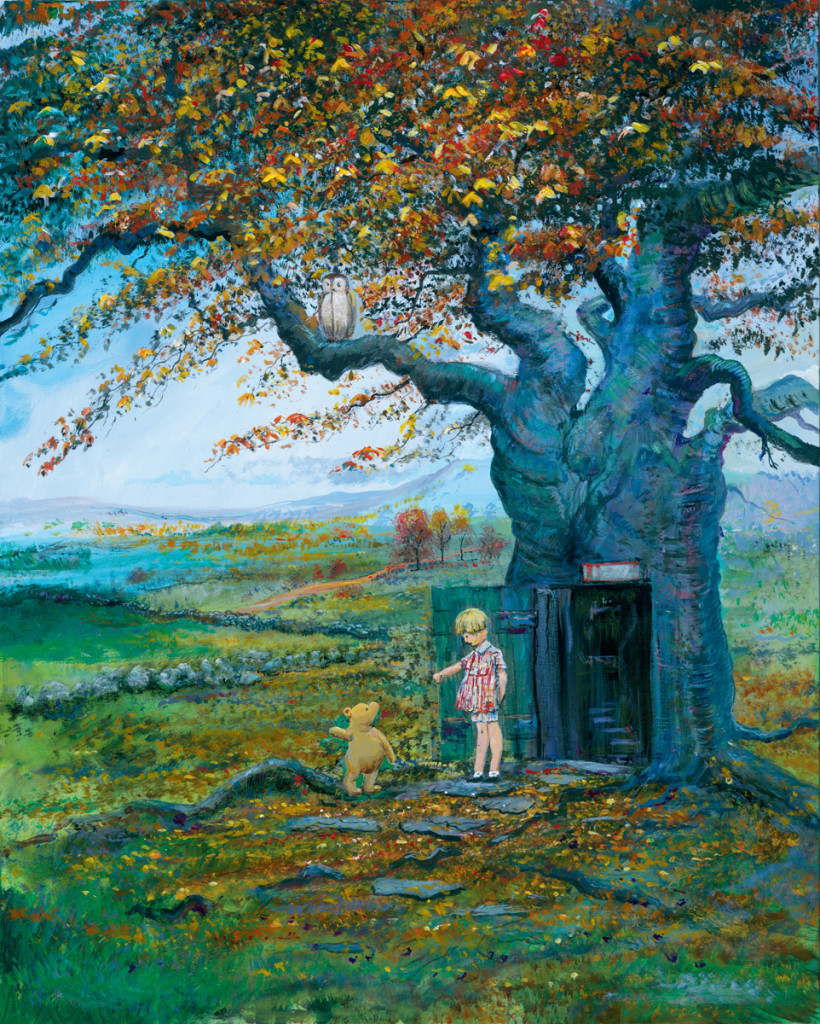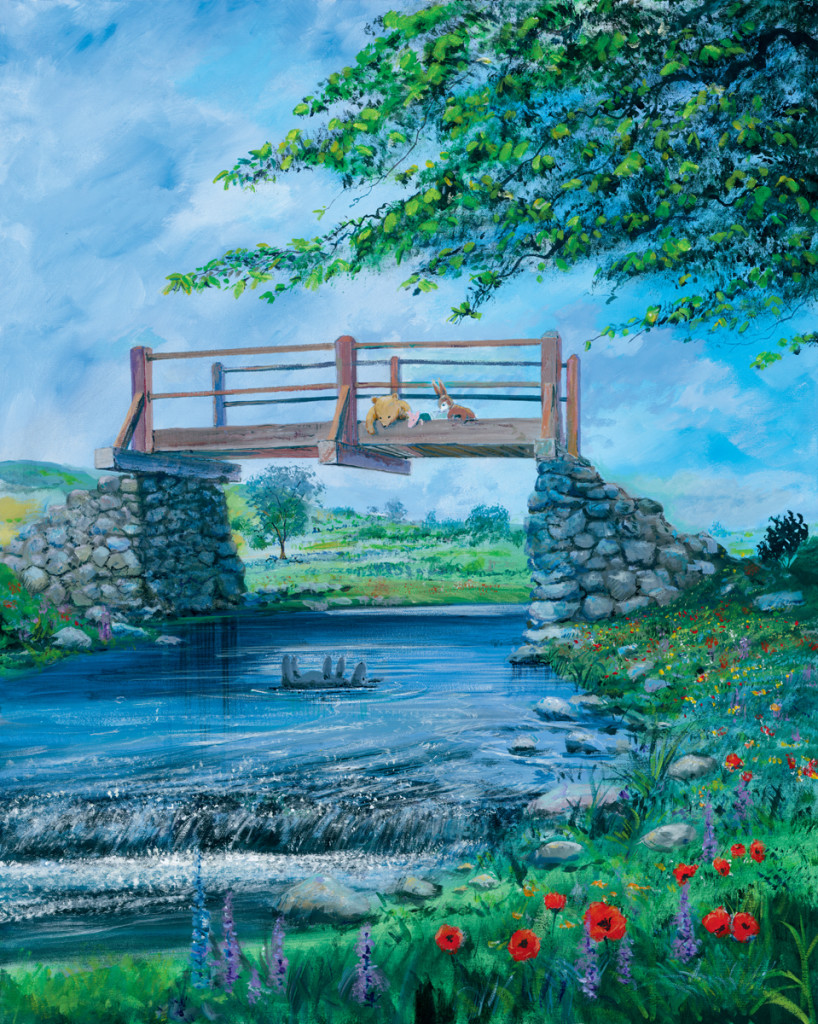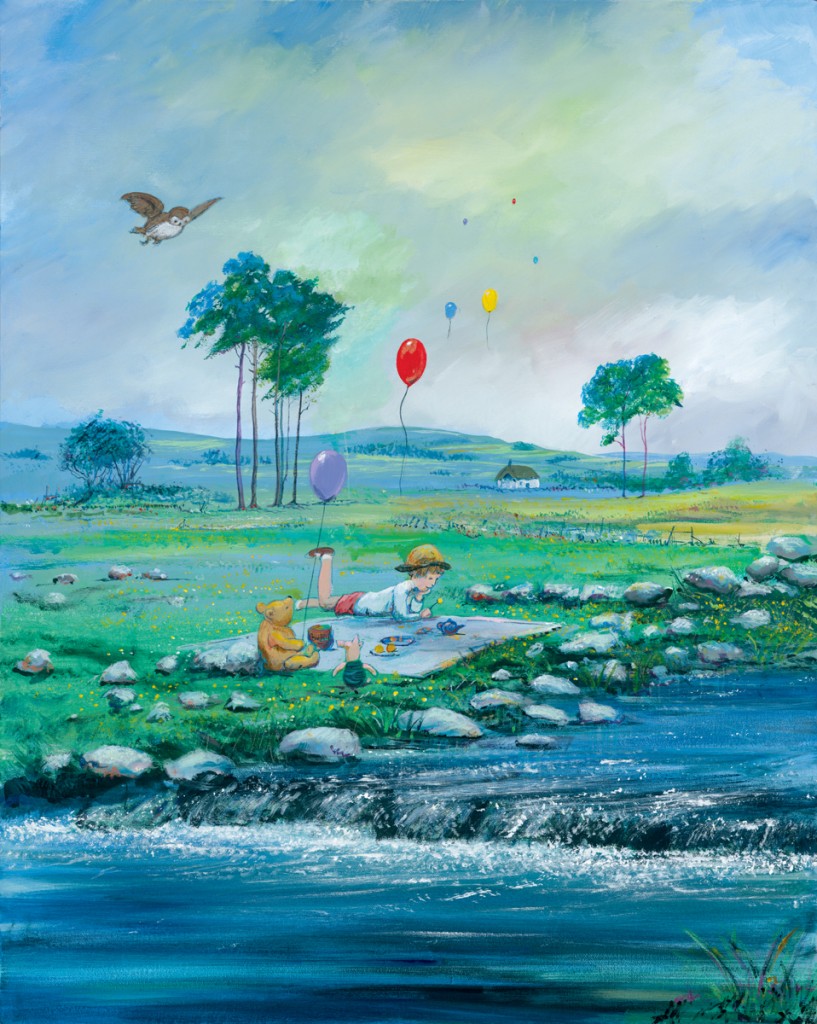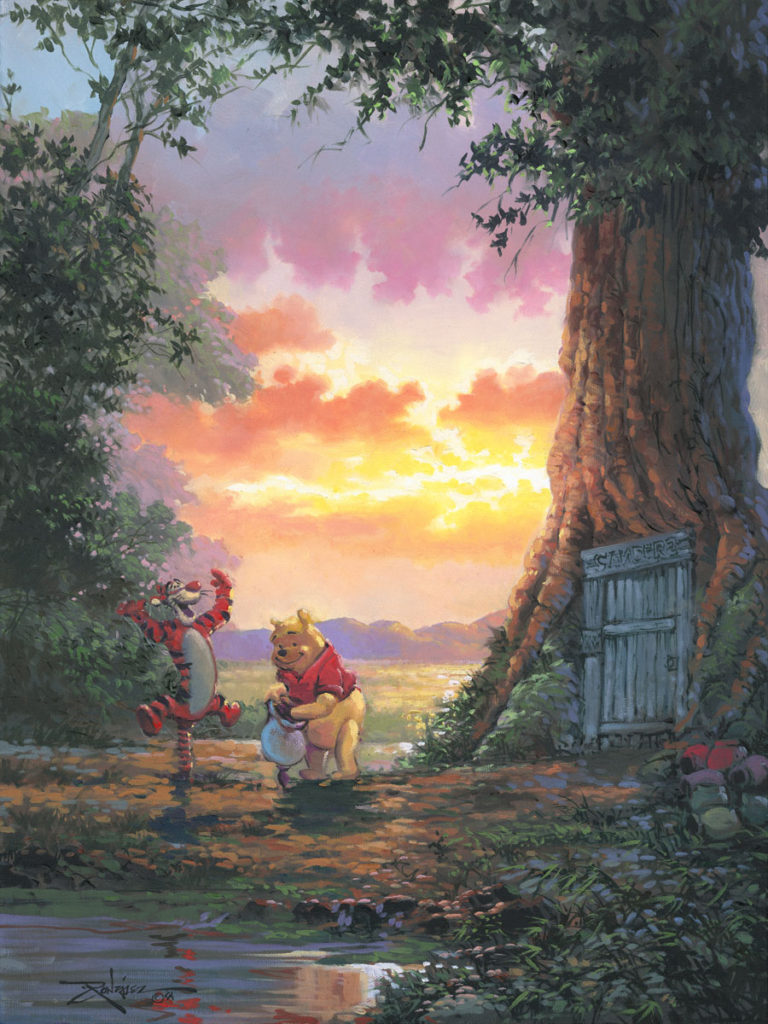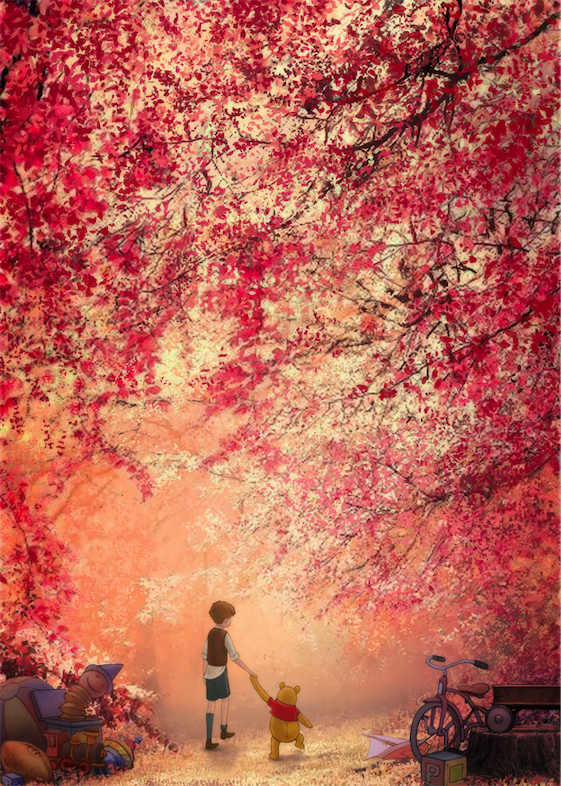It’s actually officially spring, and so like the bear with very little brain, i was racking mine to think of the best idea for a blog that celebrated a Disney character that exists in a natural world we’d most enjoy in spring, and of COURSE I realized Winnie the Pooh is the perfect subject! Then I went down a “rabbit hole” (although he’s my least favorite character) doing research about the history of Pooh. Everyone knows A.A. Milne and E.H. Shepard wrote and illustrated the original stories and Disney created the cartoons starting in 1966, but there’s so much more to know about England’s beloved bear and Disney’s second most successful character (after Mickey). I’m here to meet the challenge of telling you a bit more than you might already know, so let’s dive into the history and art of Winnie the Pooh together, shall we?
A LOT OF BOOK BOTHER ABOUT A GREAT BEAR:
A.A. Milne was a writer who had joined the staff of the British publication Punch in 1906. His son Christopher Robin was born in 1920, and inspired by him, he wrote a collection of poems, When We Were Young, illustrated by Punch staff political cartoonist E.H Shepard, in 1924. They followed that with short stories which included those that became part of the Winnie-the-Pooh books.

The first time Winnie-the-Pooh was mentioned by name was on in a story commissioned by The Evening News for Christmas Eve, 1925. The character was inspired by a stuffed toy Milne had bought for his son, and a female bear named Winnie they’d seen at the London Zoo. That bear has its own story. A Canadian vet and soldier named Harry Colebourn bought a bear cub on a whim and brought her (yes, Winnie, named after his home town of Winnepeg, was a girl cub) from Canada to England, where she became the mascot for his militia cavalry regiment. While he was in France, he kept Winnie at the London Zoo, where she became a star attraction. It was there that Christopher Robin met her. He loved the experience so much that he named his teddy bear after her.
Here’s a great piece where Harry’s great grand-daughter, Lindsay Mattick, talks about the legacy of Winnie the bear:
Inspiration for the Hundred Acre Woods for the books and, subsequently, the Disney animated shorts, is based on Ashdown Forest in East Sussex. Milne had bought a home a mile away from the Five Hundred Acre Wood, an old beech wood forest that dates from before 1670, and is now part of private land on the Buckhurst Park estate. Here are a few pictures from a part of the woods you CAN acces, photographed by travel blogger & Disney fan Nikki from Traveling With Nikki; (Please read her wonderful article HERE)
Winnie the Pooh would be nothing without the collaboration between Milne and his illustrator on the series, EH Shepard, and the writer knew that, although before they worked together on their first project, neither thought Shepard’s illustrations were a good fit. Realizing the impact Shepard’s images had on the success of Winnie-the-Pooh, Milne arranged to have him share in the royalties. You can learn so much more about A.A. Milne in this great British documentary:
Shepard did indeed have a tremendous influence of the beloved series. Not least because while the name of the character came from Christopher Robin’s toy, the look of Winnie was inspired by the toy bear Growler, belonging to Shepard’s son. Although that stuffed bear was destroyed by the family dog, the toy belonging to Milne’s son is housed at the New York Public Library, where it has been since 1987, and seen by thousands of Pooh fans every year.
A success as an illustrator when still in his 20s, E.H. Shepard had created images for editions of Aesop’s Fables and David Copperfield by 1907. He was an officer of note during World War 1, receiving the Military Cross, all while still contributing as Punch’s leading political cartoonist. Both his children, Graham and Mary, were also illustrators. Mary Eleanor Jessie Knox is known for her work as the artist in Mary Poppins, by TJ Travers. Although in 2022, an image by Shepard from Winnie the Pooh broke an all-time record as the highest price paid for an illustration, he had a long and storied career, which you can see in this video:
In 1930, the merchandising and media rights to Winnie-the-Pooh were bought by Stephen Slesinger. It must have been the best business decision he’d ever made! By 1931, it was a $50 million a year business, with Milne retaining 66% of the sales income. Slesinger is credited with showing Winnie in his red shirt for the first time, which you can see here on the 1931 board game: (We’ve gotten used to him in red, but honestly, in retrospect, it looks kind of weird, right?)

After Stephen’s unexpected passing in 1953, it was his widow Shirley that took over all things Winnie. She licensed the rights to Disney at the same time the Milne family did so, in 1961.
WALT DISNEY’S WONDERFUL WINNIE:
Walt was interested in getting the film rights to Pooh as early as 1938, when he saw his daughter Diane was enamored with the books, but it wasn’t until the 60s that he made a deal with both Milne and the Slesinger family. Then Walt was all in. By 1964, Disney was planning to create a featurette based on the books to attach to a live action release. It was Walt who dropped the hyphen in Winnie the Pooh’s name, (so if you’re English, feel free to keep adding them!) Their first release was 1966’s Winnie the Pooh and the Honey Tree, and was included in a double bill with live action feature The Ugly Dachshund. The Honey Tree was based on the first two chapters of the first book. Wolfgang (Woolie) Reitherman was tapped to direct. He was one of the “Nine Old Men” of Disney, and worked on every feature from Snow White through Fox and the Hound, becoming director with 101 Dalmatians in 1960. For Honey Tree, he cast his son Bruce to play Christopher Robin, who also voiced Mowgli in The Jungle Book. In later featurettes, other voice actors were used for the same character.
Meanwhile, some great voice actors were used longterm for other characters and roles in the film. First, of course, is Sebastian Cabot. You would know him as Bagheera in The Jungle Book, but he’s also the narrator for the Winnie the Pooh series. Barbara Luddy, who voiced Lady in Lady and the Tramp, voices Kanga. Clint Howard, brother to actor/director Ron Howard, and someone with over 250 credits starting when he was a toddler, plays Roo.
For much of Winnie’s history at Disney, Sterling Holloway voices Winnie the Pooh. He’s also the Cheshire Cat in Alice in Wonderland, Kaa in The Jungle Book, but started working with Disney early on as Mr. Stork in Dumbo and as the voice of adult Flower in Bambi. Here’s something I learned in my research for this blog: Ralph Wright, who lends his voice to Eeyore, also wrote not only most of the Winnie the Pooh featurettes, but also helped write Lady and the Tramp, Sleeping Beauty, and dozens of Disney shorts. I can never forget consummate character actor John Fiedler, who plays Piglet, also plays a key role in an original Star Wars series classic episode, “The Wolf in the Fold”. He plays Jack the Ripper! Most of my friends and clients know I’m not a fan of Rabbit (he’s such a know-it-all!) but I loved learning that the actor that voices him, Junius Matthews, also played Scottie in Lady and the Tramp, and Archimedes in Sword in the Stone.
Although Honey Tree didn’t win nor get nominated for any major awards, 1968’s Winnie the Pooh and a Blustery Day won the Oscar for Best Animated Short, and 1974’s Winnie the Pooh and Tigger Too was nominated in the same category.
In addition to those I’ve mentioned, a ton of incredibly talented animators worked on the Winnie the Pooh series, including Dale Baer, Don BLuth , Andy Gaskell, Frank Thomas and Ollie Johnston, who animated Winnie and Piglet, MIlt Kahl, who worked on Tigger, John Lounsbery, who worked on Owl, and John Pomeroy, who animated Rabbit.
The music from Winnie the Pooh was done by the legendary Sherman Brothers, who wrote the songs, and Buddy Baker, who wrote the scores for many live action features and Disney shorts between 1960 and 1981, and, notably, the Haunted Mansion at Disneyland.
While I’m not sure how long this link will be good, here’s the very informative Disney documentary on the making of Winnie the Pooh. It has EVERYONE!
POOH IN POP CULTURE:
Pooh in pop culture is represented in the most wonderful to the most bizarre ways, as is often the case with iconic characters and stories. In the wonderful column, we have the fact that they’ve been translated to not only many live languages, but also into Latin, including Winnie ille Pu, which was first published in 1958, and, in 1960, became the only Latin book ever to have been featured on The New York Times Best Seller list. Pooh has also been published in books that explain complex philosophy via the character, including the Tao of Pooh and the Te of Piglet, which explain Taoism. Pooh and the Philosophers by John T Williams considers the teachings Kant, Descartes, Plato, and Nietzsche via the bear with very little brain. Go figure!
There is a sport, Pooh Sticks, created based on the game Pooh plays with his friends where they drop sticks into a stream and see whose stick first crosses the finish line. A World Championship Pooh Sticks race takes place in Oxfordshire every year.
Depending on your perspective, this is either awesome or not. China has banned images and films relating to Winnie the Pooh, because on social media Xi Jinping has been compared unfavorably to the character. In fact, Pooh was featured on a South Park episode Band in China, and in it, Winnie the Pooh is brutally killed. As a result, South Park too was banned in China. More recently, Taiwanese air force pilots have taken to wearing patches depicting a Formosan bear punching Winnie the Pooh, meant to represent the Chinese president, as a defiant symbol of the island’s resistance to Chinese war games.
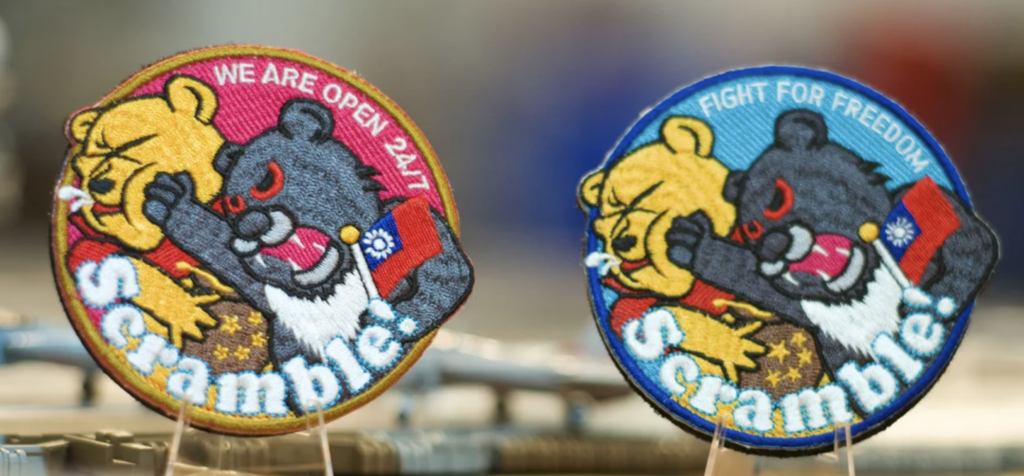
On the truly darker (and, I’ve gotta say, hilarious) side of Pooh in pop culture, we have the infamous video created that superimposes Pooh with Apocalypse Now. If you’re a fan of both and haven’t seen this, it’s a MUST-SEE. If you aren’t, avoid it. It will make you sad.
And the minute Winnie the Pooh went out of copyright, British filmmaker Rhys Frake-Waterfield created the live action slasher film Winnie the Pooh: Blood and Honey, as part of his Twisted Childhood Universe (TCU). Though considered by critics as one of the worst films ever made (that’s a hard title to win, by the way) it has made over 6 million with a budget of only $100,000. Feast your eyes, or maybe don’t, on its trailer:
===
Meanwhile, as always, ArtInsights has some wonderful images of Winnie the Pooh and friends, for fans of the films, books, and characters, and you can find them all HERE.
But of course we should show you some of the great official art of Winnie the Pooh. and Winnie the Pooh Disney fine art, so here are some of our favorites:


